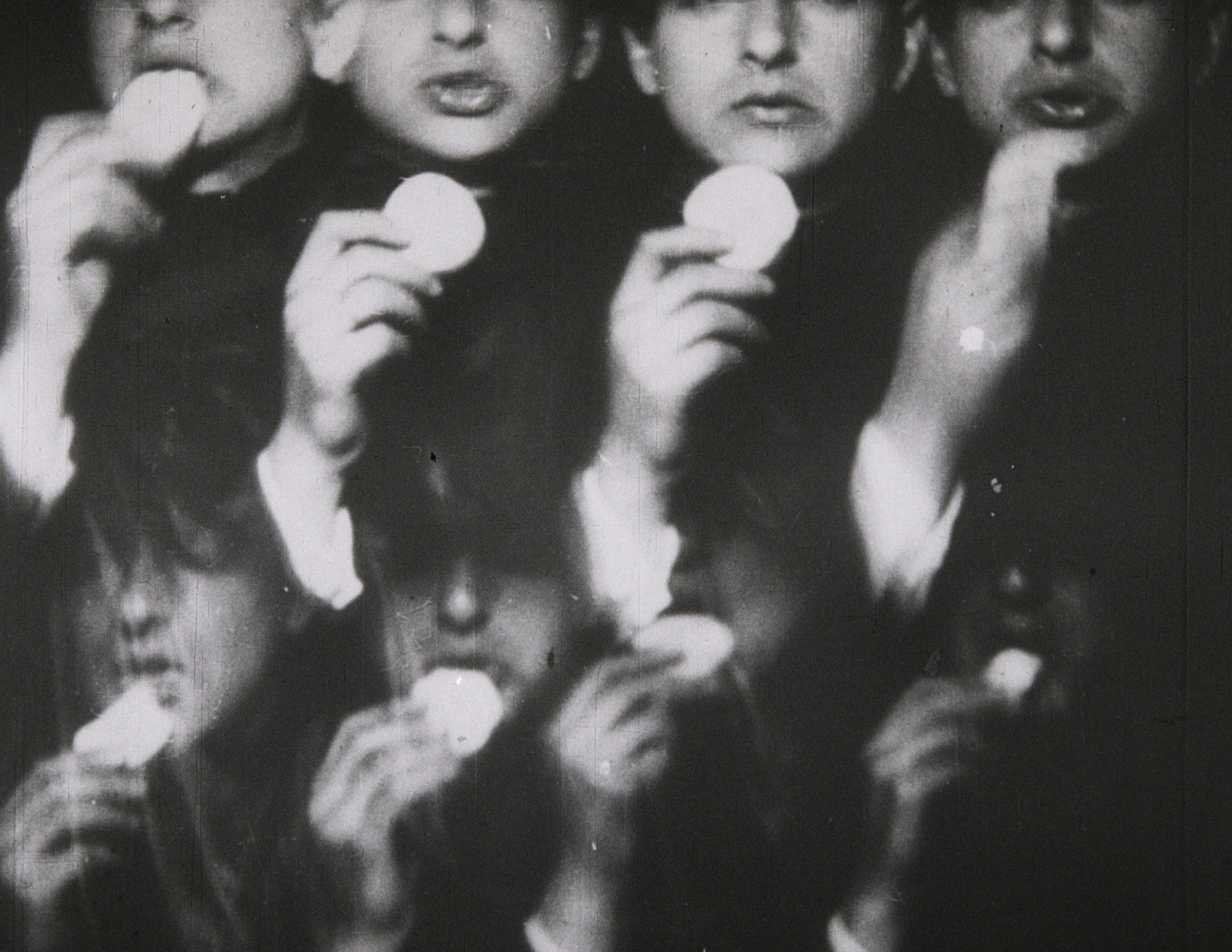Europa: The peculiar tale of the anti-fascist film the Nazis didn’t want you to see
The Polish avant-garde silent flick is finally getting its premiere in London, 80 years after it was made, though its themes still pack a punch. Pamela Hutchinson talks to the curators involved in restoring a lost masterpiece and how they brought it to the big screen

Polish artists Stefan and Franciszka Themerson went to their graves believing that the most important film of their career was lost forever. They had made the short film Europa at their home in 1931, with barely any budget, using a borrowed camera and a cast of family and friends – nevertheless, it was acclaimed as the finest work of the Polish avant-garde. But when the Themersons deposited it for safekeeping in 1938, they never saw it again. The film, along with so many other precious works of art, was seized by the Nazis and 50 years later the Themersons died believing it had been destroyed.
Miraculously, and thanks largely to the efforts of a team from Berlin’s Pilecki Institute, Europa has now been found, retrieved and restored, to be preserved in the BFI National Archive and finally shown on the big screen next week. Two years ago, the film was located in storage at the Bundesfilmarchiv in Germany; now the Commission for Looted Art in Europe (CLAE) has recovered it on behalf of the artists’ estate. The restored print will have its world premiere at the BFI London Film Festival, where it will be introduced by the Themersons’ niece, the critic and curator Jasia Reichardt, who has been taking care of the artists’ archive since their deaths in 1988. The silent film will screen with a newly commissioned soundtrack by Dutch composer Lodewijk Muns.
It’s “a major and very exciting acquisition,” says Will Fowler, the archive’s curator of artists’ moving image, not least because of its “politically radical” nature. Europa is an electric shock of a short film, with an explicitly anti-fascist theme, inspired by history unfolding around the Themersons in Warsaw at the turn of the Thirties, and adapted from Anatol Stern’s 1925 futurist poem of the same name. The film uses graphic imagery to convey the horror of creeping fascism across the continent: a suited man gorging on rare meat, another swallowing newsprint. There are extreme, polarised closeups, screams of terror, photographic collages, a beating heart shown in X-ray, a crucifixion and a First World War trench, punches and gunshots. Film threads through a camera, while fast edits evoke the tension of living in a climate of fear and hatred.
“It is about the tragedy of Europe. Europe eats itself to death,” says Reichardt. “And I think 2019 was the right moment to find it because Europe was in trouble. Of course, it still is.”
The sting in this tale is that Europa fell victim to the fascist ideologies that it warned about, and became one of countless cultural objects to be stolen by the Nazis. “In the course of the 22 years that we’ve been doing this work, we’ve recovered over 3,500 items of cultural property for individuals, families and institutions,” says Anne Webber, founder and co-chair of the CLAE. “This was the first film that ever came our way.”
“I’d always been passionate about avant-garde films so the idea of recovering a film of this importance was close to my heart,” she continues. “The meaning of what we recover obviously goes far beyond the object itself. Whether it’s a painting or a book or a film, it’s the meaning of it to the people from whom it was taken. To the Themersons, as the creators of such an original and important work, the loss of this film had a special significance.”
The Themersons were a married couple: Stefan wrote before he began experimenting with photography while Franciszka was a painter, designer and illustrator. They began to collaborate on filmmaking in the early Thirties – but with few means. “They had no camera. They had to borrow a box camera. There was no film school, and there was no money. Europa was made in the room which they shared, after they got married,” says Reichardt. This stunning film was a homespun, DIY creation.

“Stefan called the technique that he used for making images for his films ‘photograms in motion’,” says Reichardt. “One of Stefan’s colleagues at the university told me that he visited them in that room and he could see paving stones on the table and between them there was soil and there was a bit of grass.” You’ll see those very slabs in the film, in a stop-motion sequence that illustrates Stern’s words: “This green blade of grass/squeezed up between two paving stones/this wreck tearing itself loose/on the chequered/stony/Atlantic/is the messenger of death”.
Stern himself endorsed Europa: he was very happy with how the Themersons had translated his words into such indelible images. The reviewers were also impressed. “One of the critics writing about the film in 1933 said about it, ‘This is a film poem.’ It was a revelation,” says Reichardt. “One of the best-known critics said, ‘At last, I can say, ‘It’s a good film’.”

Watch Apple TV+ free for 7 day
New subscribers only. £9.99/mo. after free trial. Plan auto-renews until cancelled.
ADVERTISEMENT. If you sign up to this service we will earn commission. This revenue helps to fund journalism across The Independent.

Watch Apple TV+ free for 7 day
New subscribers only. £9.99/mo. after free trial. Plan auto-renews until cancelled.
ADVERTISEMENT. If you sign up to this service we will earn commission. This revenue helps to fund journalism across The Independent.
Had it been available to view during these intervening years, Europa’s influence on film history would have been incalculable. “The film itself is stunning, a highly worked and brilliantly constructed piece of avant-garde cinema, the anti-fascist message of which and the potency of it as art still punches through the decades,” says Fowler.
For more than 80 years, though, the short has been only a memory. “The Themersons were very concerned about Europa when it disappeared,” says Reichardt. “Because Stefan thought it was important for him to recover something of that film, he made a reconstruction of it from the bits of film and the stills which he had. First he re-issued the book [of the poem], and then he made the reconstruction at the London Film-Makers’ Co-op [in 1983-4].” Then in 1988, another artist, Piotr Zarębski, made his own reconstruction, Europa II, in tribute. The remakes will be shown alongside the restored original film at the LFF screening on 6 October.
“Not only does the legend of Europa precede it, but its story as an object passing through different hands and labs, including those of the Nazis, is quite extraordinary,” says Fowler. The tale begins when the Themersons left Poland for Paris in 1938, and deposited their films in the Vitfer Laboratory before volunteering for the Polish Army. For decades that is also where the story ended: the Nazis seized their films from the lab and the couple moved to England during the war, where they continued to make films, but without hope of screening Europa again.
“In France, they banned films very early in the war,” says Webber. “Avant-garde films would be absolutely banned because they fell in the category of modern art, which was thought to be ‘degenerate’ and dangerous by Hitler. ‘Degenerate art’ was seized from museums and private individuals. It was the same with this kind of film. They were seized and would never have been shown.”

“There was an order from Hitler to secure works of art in June 1940, after the armistice was signed,” says Webber. “The Nazis went on to seize everything they could. They seized paintings, books and manuscripts. They seized films, pianos, violins. They also seized furniture, plates, knives and forks and glasses and everything that people had in their homes. But they certainly seized films.”
Naturally, given the film’s subject matter, the Themersons feared the film would become a casualty of war. “People thought that after the Nazis seized ‘degenerate art’, a lot of it was destroyed, but very few works of art were ever destroyed by the Nazis. While disliking it and disliking the values and ideas that it represented, they understood its cultural and especially its financial value,” says Webber. “They didn’t destroy what they seized, even if it ran counter to the ideological message they wanted to convey.”
The film was instead kept in the Reichsfilmarchiv, the Nazi regime’s state film archive. Much of the stock in this archive was taken by the Soviet Army in June 1945, and transported to Russia. After the formation of East Germany, some of those films were returned to the DDR’s new state archive, which following the fall of the Berlin Wall, a year after the Themersons’ deaths, became the Bundesarchiv. Simply by remaining in one collection, the film crossed geopolitical borders.
Reclaiming a work of looted art is far from straightforward. “We always do our own research to establish the history of an object and the circumstances of its loss before we make a claim. I entered into correspondence with the Bundesarchiv to clarify exactly what they had,” says Webber. “Once you’re sure that it is the looted object in question, then you start the process of negotiating and making a claim for it.”
The recovery of a Thirties 35mm film print posed its own challenges. “Nitrate is flammable so you have to be very careful transporting it,” says Webber. “The Germans told us it was subject to restrictions under their explosives law.” But in fact, Europa’s return journey was safe, and swift. “I’m just so delighted that we were able to achieve the restitution of it,” says Webber, “and delighted we were able to achieve it in record time as well, because it can often take several years.”
Now the film is safe, but also ready to embark on new journeys, as cinephiles across the world will be keen to see this much-talked about, mysterious film. Europa remains a stark warning about the rise of the far right, and in its own terrible history, a cautionary tale about protecting art from ideological suppression and theft.
‘Europa’ screens at the BFI London Film Festival on 6 October at BFI Southbank
Join our commenting forum
Join thought-provoking conversations, follow other Independent readers and see their replies
Comments


Bookmark popover
Removed from bookmarks